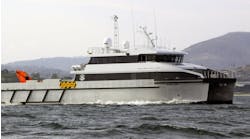Carlos Godinho - Prysmian
Submarine cable technology and the ability to transport huge blocks of energy over very long distances have evolved significantly over the past few years. Now, the new discoveries in Brazil’s Santos basin require solutions to produce oil and gas in water depths of more than 10,000 ft (3,048 m).
Due to the potentially huge quantities of gas available for transportation to the shore from offshore facilities, various associated power transmission concepts are under evaluation, including “gas to wire”. In this case, electrical energy would be generated offshore by gas turbines, then transmitted by submarine cable to shore.
Prysmian umbilical manufacturing plant.
In Brazil, installation of submarine cables for various uses began in the mid-1950s and has become common, not only for distribution at medium voltage, but also for transmission at 245 kV. One recent example was an installation connecting the island of Florianopolis in Santa Catarina province to the shore. During the 1970s and ’80s, many islands to the southeast and northeast, some up to 40 mi (64.4 km) offshore, were connected to the mainland via submarine energy and telecommunications links.
For Brazil’s oil industry, the first implementation of submarine cables to transmit energy between platforms was in 1988, when the Polo Nordeste platforms were connected by a 25 kV, 300 sq mm EPR cable in shallow water.
The cable was 33 mi (53 km) long in a static application, and its success led to the adoption of a submarine power cable in the world’s first subsea pumping system, installed in 1994 in the Campos basin in 300 ft (91.44 m) of water. This required the development of a dynamic medium voltage three-phase cable.
In 1998, a second subsea pumping system at Albacora Leste was installed in almost 3,500 ft (1,067 m) of water. In this case, the transformer and frequency variation device for electric pump speed control were installed in a “wet” environment.
At that time, Pirelli Cabos (the forerunner of Prysmian Cabos e Sistema do Brasil) signed a technical co-operation agreement with Petrobras to develop optical and power submarine cables for application – under dynamic conditions – in up to 6,200 ft (1,890 m) of water. This was achieved through transferring experience the company had acquired developing electro-hydraulic umbilicals for applications in up to 6,500 ft (1,981 m) water depth.
Dynamic behavior studies
The increased use of dynamic submarine cables requires a suite of complex engineering software to analyze dynamic behavior of the cable system under expected environmental conditions. This led to product development and testing to verify both the accuracy of the software tools themselves and the cable systems.
One such example is StatoilHydro’s Peregrino project in block BM-C-007 in the southern Campos basin. The project is being developed using an FPSO connected to two fixed wellhead platforms. Two 15kV, 500 sq mm dynamic power umbilicals, one 5,200 m (17,060 ft) and the other 6,577m (21,578 ft) long, will supply power from the FPSO to each platform.
The first use of submarine cables for connecting deepwater semisubmersibles and platforms was in 1999in Roncador, Campos basin. That technology has been extended to other projects.
New challenges
But the challenges lie not just in water depth, but also in the distance between connecting sites which can be more than 200 mi (322 km), with power requirements of up to 1 GW.
Over the last three decades, Prysmian has developed in other industries giant submarine AC and DC transmission systems for static applications with voltages of up to 500 kV AC and 525 kV DC. Many of these were produced by the company plant in Naples.
The company also was in studies in Brazil and Europe to develop submarine cable technology to transport almost 1 GW generated on floating offshore facilities in deepwater conditions to the shore at distances of more than 200 mi. It currently is working on new materials and equipment for DC conversion to meet the power requirements for Brazil’s new discoveries such as Jupiter in the pre-salt layer in the Santos basin at a depth of 5,000 m 16,404 ft and the giant Tupi oil field.
For submarine transmission of electrical power in giga-watts over distances longer than 100 mi (161 km), AC systems are constrained by their high capacitive behavior, which is influenced very much by cable length and power capacity. The superior resistive behavior of DC systems overcomes these limitations.
In future, as use of large power systems offshore becomes more common, new developments such as insulation material for dynamic HVDC insulated cables, components and equipment for very high pressure and harsh environment conditions.
Applications involving both multiple pumping units and subsea separation will require complex electrical systems with appropriate designs to overcome the attendant electrical phenomena.




